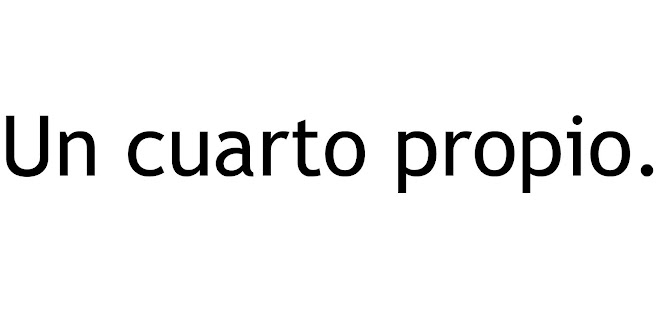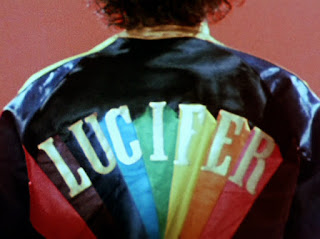Dan Graham
miércoles, 29 de noviembre de 2017
Etiquetas:
american,
conceptual art,
instalacion,
land art,
mirror glasses,
photography,
Sculpture,
structure,
writer
miércoles, 15 de noviembre de 2017
martes, 14 de noviembre de 2017
Etiquetas:
16mm,
ceremony,
color,
Egypt,
experimental film,
invocation jimmy page,
kenneth anger,
optical printer,
psychodelia
lunes, 13 de noviembre de 2017
Etiquetas:
apropiacion,
artist,
book,
conceptual,
feminismo,
found pictures,
NY,
photography,
publication,
USA
jueves, 9 de noviembre de 2017
Documentary uncertainty by Hito Steyerl
I vividly remember a strange broadcast a few years ago. On one of the first days of the US invasion of Iraq in 2003, a senior CNN correspondent was riding in an armored vehicle. Jubilantly, he stuck a direct broadcast cell phone camera out of the window. He exclaimed that never before had this type of live broadcast been seen. And that was indeed true. Because one could hardly see anything on these pictures. Due to the low resolution, the only things in sight were green and brown blotches, slowly moving across the screen. Actually, the picture looked like the camouflage of combat fatigues; one could only guess at what these abstract compositions were supposed to depict.
Are these documentary images? If we use a conventional definition of the documentary, the answer to this question is obviously no. They bear no similarity to reality; we have no basis for judging whether reality is being shown here in any objective way. But one thing is clear: they seem real enough. No doubt many people in the audience think they are documentary images. Their aura of authenticity is a direct result of their unintelligibility.
The answer lies in their lack of focus, their uncertainty. This lack of focus does not only give the images the desired feel of authenticity; it is also very revealing, if one looks more closely. Because by now, this type of image has become ubiquitous. We are surrounded by rough-cut and increasingly abstract “documentary” images, shaky, dark, or out-of-focus, images that show little else than their own excitement. [1] The more immediate they become, the less there is to see. They evoke a situation of permanent exception and constant crisis, a state of heightened tension and vigilance. The closer to reality we get, the less focused and jumpier the image becomes. Let us call this the uncertainty principle of modern documentarism.
The answer lies in their lack of focus, their uncertainty. This lack of focus does not only give the images the desired feel of authenticity; it is also very revealing, if one looks more closely. Because by now, this type of image has become ubiquitous. We are surrounded by rough-cut and increasingly abstract “documentary” images, shaky, dark, or out-of-focus, images that show little else than their own excitement. [1] The more immediate they become, the less there is to see. They evoke a situation of permanent exception and constant crisis, a state of heightened tension and vigilance. The closer to reality we get, the less focused and jumpier the image becomes. Let us call this the uncertainty principle of modern documentarism.
In the age of digital reproduction documentary forms do not only have an incredible emotionalizing effect on an individual level; they are also an important part of the contemporary economy of affect. The need for objective, institutionally guaranteed, even scientific integrity is successfully being replaced by the desire for intensity. [2] In the ubiquitous flows of information societies, sound argumentation is displaced by identification, by compromised messages and affects that are more and more interwoven with the events themselves. [3] Documentary material may have once seemed to be as dry as dust, related to the notoriously cool procedures of jurisprudence or science. But by now, the institutionalization of doubt makes the documentary image into a collection point for emotions just as intense as they are contradictory.
Documentary forms convey, regulate, and administrate huge emotional potentials that they both keep in check and unleash explosively. They bring distant events close enough to get under our skin, and alienate what is closest to us. They heighten a general sense of fear that increasingly being used as a political instrument. As Brian Massumi has shown, power now targets our feelings directly; television in the age of terror creates a “networked jumpiness.” [4] The aforementioned pictures on CNN also follow this logic: they are no longer about information that could be mediated through simple, intelligible images. Instead, they are all about an admixture of panic and excitement that comes from the feeling of “being there.” We do not need to see anything concrete to feel the atmosphere of war.
In this affective mode, documentary forms create false intimacy and even false presence. They familiarize us with the world but give us no possibility for taking part in it. They show us difference but sow enmity. Their shock effects are amplified; they can trigger horror and disbelief, just as they can bring endless relief and satisfaction. Doubt as to the truth-value of the documentary claim is actually part of this series of emotional simulations. It is precisely the documentary image’s exited lack of focus, not its clarity, which gives it such a paradoxical power.
However, this hardly means that we no longer need to think about documentary truth. The fact that no one really knows what this means is secondary in the light of all the repercussions. Paradoxically, documentary images are so powerful because there is no more unbroken belief in their truth. The uncertainty that documentary truth provokes is a central component of a general incertitude that is becoming stronger and stronger. Its consequences are ubiquitous: they manifest themselves in the form of military interventions, mass hysteria, global campaigns, and even entire world views that can take on a global significance within a matter of days.
In this sense, the question of documentary truth displaced itself. It no longer ask whether documentary images correspond to reality or not. To the abstract documentarism of CNN, the question of correct representation is utterly secondary. These images do not represent anything intelligible any more. However, their truth lies in their expression. Those CNN images still vividly and acutely express the uncertainty, which governs not only contemporary documentary image production, but also the contemporary world as such. They are perfectly true documents of that general uncertainty, so to speak. They reflect the precarious nature of contemporary lives as well as the uneasyness of any representation. The abstract pixels that flicker across the screen are the crystal clear expression of a time in which the connection between images and things has become questionable and is under general suspicion. They document the uncertainty of representation, just as they bear witness to a stage of visuality increasingly defined by images where one can see less and less.
Expression instead of representation: this is the level upon which the CNN-images reveal their truth. On the level of form, the truth of these images is that the form of their construction presents the real image of their conditions. Their content can correspond to reality, but it doesn’t have to; doubt will never be cast aside fully. The way in which reality presses its into form is mimetic and unavoidable; it cannot be circumvented.
Does the documentary image represent? Maybe. One can, however, be certain that it presents its own context by expressing it. In the midst of all this uncertainty, this is something we can be certain of, insofar as documentary forms are concerned. But there are many open question. One of these is the meaning of critique, a notion that had historically entered into unspoken symbiosis with documentary images, and one that is now undergoing a dramatic change. In Great Britain, “critical” is now the higher stage of danger, a point in time when terrorist attack is imminent. What does this drastic transformation of “criticality” mean for critical images? How can they keep pace with this change in meaning?
Or, to ask differently: how can one reclaim a documentary distance that would once again free up a vantage onto the world? Where should one locate the standpoint of this picture, if we are all always-already embedded into the power of the image? Such distance cannot be defined in spatial terms. It needs to be thought ethically and politically, from a temporal perspective. We can only regain critical distance from the perspective of the future, a future that has already changed and that released images from their enmeshment in power. In this sense, critical documentarism cannot show what is always present, namely embedding in the relations we call reality. From this perspective, the only real documentary image is the one that shows something that does not yet exist and maybe come one day.
[1] Cf. John Fiske , „Videotech”. In: Visual Culture Reader. (Hg.) Nicholas Mirzoeff. London/New York, Routledge 1998. Pp.153-162
[1] Cf. John Fiske , „Videotech”. In: Visual Culture Reader. (Hg.) Nicholas Mirzoeff. London/New York, Routledge 1998. Pp.153-162
[2] Cf. Jay G. Blumler The new television marketplace: imperiatives, implications, issues. In: James Curran, Michael Gurevitch Mass Media and Society London/New York/Melbourne/Auckland: Edward Arnold. Pp. 194-216. Esp. S208ff.
[3] Cf. Scott Lash Critique of Information, London: Sage. 2002.
[4] Brian Massumi, Fear (The spectrum said) in: Multitudes. https://multitudes.samizdat.net/Fear-The-spectrum-said.html
Etiquetas:
artist,
authenticity,
documentary,
essay,
evidence,
media,
photography,
surveillance,
technology
miércoles, 8 de noviembre de 2017
martes, 7 de noviembre de 2017
lunes, 6 de noviembre de 2017
miércoles, 1 de noviembre de 2017
Suscribirse a:
Entradas (Atom)










































